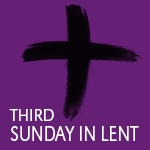 The Gospels of the last two Sundays showed us that the Christian journey is from Temptation to Transfiguration. The Gospels of the next three Sundays of Lent present Jesus as the road (or The Way, as the early Christians referred to him) from temptation to transfiguration.
The Gospels of the last two Sundays showed us that the Christian journey is from Temptation to Transfiguration. The Gospels of the next three Sundays of Lent present Jesus as the road (or The Way, as the early Christians referred to him) from temptation to transfiguration.
In the Old Testament scriptures the idea of the people of Israel being ‘the people of God’ is clearly established. By their behaviour they were to be a ‘light to the nations’, and the dwelling-place of God’s presence. Only much later did the idea of God dwelling in a building called a temple develop. Even so, the Jews never lost the sense that they were to be God’s own people.
The first reading from Exodus (commonly known as the Ten Commandments) gives a pattern for God’s people to live in right relationship with God and neighbour; to be the dwelling-place of God’s presence.
In today’s Gospel we find a deeply passionate Jesus causing a near-riot in the outer precincts of the Temple. In John’s Gospel Jesus’ prophetic actions have less to do with ‘cleansing the Temple’ than with saying that the Temple is no longer the way to be in right relationship with God.
According to John, Jesus is the new, living temple of God’s presence and the meeting place between God and his people. Jesus is the way to be in right relationship with God and neighbour.
In our Catholic tradition we often refer to ourselves as ‘temples of the Holy Spirit’. We recognise that we are sacred beings destined for union with God, people in whom the reign of God’s goodness should be clearly seen in word, thought and action.
Lent is a time to decide what our life is about and what is important. Like Jesus in the Temple maybe we need to put an end to ways of thinking and behaving which clutter our lives, obscure God’s presence and fail to bring life to others.
As members of the Body of Christ we, too, are to be the place where God is found on earth.














